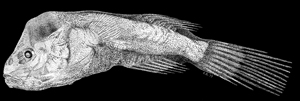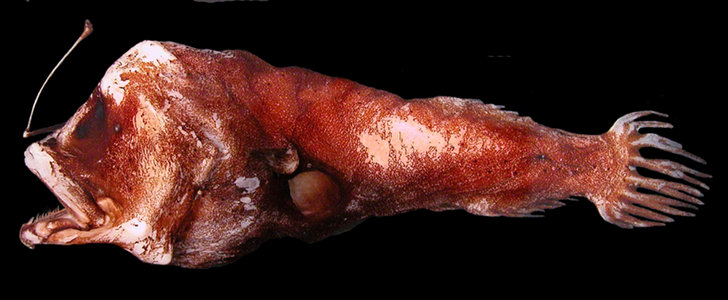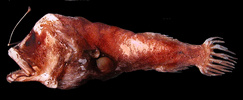Centrophrynidae
Centrophryne spinulosa
Prickly Seadevils
Theodore W. PietschIntroduction
Although now recognized as unique among ceratioid families, the Centrophrynidae has been confused with oneirodids, while, at the same time, bearing a superficial similarity to ceratiids, especially members of the genus Ceratias. A single genus and species, Centrophryne spinulosa Regan and Trewavas, 1932, is currently recognized, found in all three major oceans of the world in tropical and subtropical latitudes.
Characteristics
Diagnosis
Larvae and adolescents of both sexes of the family Centrophrynidae are unique among ceratioids in having a small digitiform hyoid barbel (a hyoid barbel is present elsewhere in the suborder only in females of the linophrynid genus Linophryne).
Metamorphosed females of the family Centrophrynidae are distinguished from those of all other ceratioid families in having a single oval-shaped ovary (ovaries are paired in all other ceratioid families; see Pietsch, 1972a:24, fig. 5). They differ further in having the following combination of character states: supraethmoid present; frontals narrowly separated by cartilage along dorsal midline, each without a ventromedial extension; parietals present; sphenotic spines absent; pterosphenoid, metapterygoid, and mesopterygoid present; hyomandibular with a double head; hypohyals 2; branchiostegal rays 6 (2 + 4); opercle bifurcate, dorsal fork short, less than 50% length of ventral fork; subopercle long and slender, at least as long as ventral fork of opercle, with a slender tapering upper end, lower end with a well-developed spine on anterior margin (less conspicuous in large females); quadrate and articular spines minute; angular and preopercular spines absent; jaws equal anteriorly; lower jaw with a well-developed symphysial spine; postmaxillary process of premaxilla absent; anterior-maxillomandibular ligament long, well developed; pharyngobranchial I present, suspensory in function; pharyngobranchials II and III well developed and toothed; pharyngobranchial IV absent; hypobranchials I-III well ossified; only a single ossified basibranchial; teeth present on epibranchial I and ceratobranchials I-IV; epibranchial I free, not bound to wall of pharynx by connective tissue; proximal one-third to one-half of ceratobranchial I bound to wall of pharynx, distal one-third free; distal end of ceratobranchial I not bound by connective tissue to adjacent ceratobranchial II; proximal one-quarter to one-half of ceratobranchials II-IV not bound together by connective tissue; epurals absent; hypural plate with deep posterior notch; pterygiophore of illicium bearing a small ossified remnant of second cephalic spine; escal bulb and central lumen present, esca without tooth-like denticles; posteroventral process of coracoid absent; pectoral radials 4, fusing to 3 in specimens greater than 150 mm; pelvic bone present, only slightly expanded distally; dorsal-fin rays 6-7; anal-fin rays 5-6; pectoral-fin rays 15-16; pelvic fins absent; caudal rays 9 (2 simple + 4 bifurcated + 3 simple); skin covered with numerous, close-set dermal spinules; pyloric caeca absent.
Males (known only from three specimens, one adult and two in metamorphosis) differ from those of all other ceratioids in having a short hyoid barbel situated behind tip of lower jaw. They are further unique in having the following combination of character states: eyes unusually small, without aphakic space; olfactory organ relatively large, anterior nostril directed anteriorly, about half size of posterior nostril; a triangular upper denticular plate on tip of snout, bearing a transverse series of three well-developed hooked denticles; a crescent-shaped lower denticular plate, with a transverse series of four strong, symmetrically placed denticles, fused at base; skin naked, without dermal spinules (Bertelsen, 1983:313, fig. 2); free-living, no evidence of sexual parasitism (see Pietsch, 2005).
Larvae (two known specimens, a female, 4.2 mm SL; and a male, 7.5 mm SL) with body relatively short and deep; skin moderately inflated; a short, digitiform hyoid barbel; pectoral fins of normal size, not reaching to base of dorsal and anal fins; pelvic fins absent (Bertelsen, 1951:126, fig. 85A; Bertelsen, 1984:329 fig. 168F).
The osteological features cited here and elsewhere in this account of the Centrophrynidae are based on examinations of two adolescent females, one larval male, and one adult male (Bertelsen, 1951:124, fig. 84; Pietsch, 1972a:26-43, figs. 7-24; Bertelsen, 1983:313-314, fig. 3).
Description
Metamorphosed females with body long and slender, not globular, depth approximately 35-40% SL; maxilla terminating below eye in smaller specimens (less than approximately 150 mm), extending posteriorly beyond eye in larger specimens; a large oval pit just anterior to eye in specimens approximately 40 mm and larger; oral valve well developed, lining inside of both upper and lower jaws; a short hyoid barbel present in larvae and adolescent specimens less than 50 mm SL, reduced to a minute protuberance or lost in larger specimens (Pietsch, 1972a:24, fig. 4); two nostrils on each side, at end of a single short tube; teeth slender, recurved and all depressible, large and small intermixed in both jaws; teeth of lower jaw generally larger but less numerous than those of upper; number of teeth in lower jaw 23-96, in upper jaw 32-153; an increase in number of teeth in both jaws with increasing standard length up to approximately 80 mm SL, but a decrease in number with further growth; vomerine teeth 0-9; epibranchial and ceratobranchial teeth: 3-4 broad-based tooth plates on epibranchial I and 5-16 similar tooth plates on ceratobranchials I-IV (see Pietsch, 1972a:36, fig. 15); epibranchial I free from wall of pharynx; epibranchials I-IV closely bound together; proximal one-third to one-half of ceratobranchial I bound to wall of pharynx, distal two-thirds to one-half free; epibranchial IV and ceratobranchial IV bound to wall of pharynx, no opening behind fourth arch; gill filaments present on proximal tips of epibranchials II-III, on proximal tip of ceratobranchial I, and full length of ceratobranchials II-IV; pseudobranch absent; length of illicium of females 18.7-26.0% SL; anterior end of pterygiophore of illicium exposed, emerging on snout, its proximal end concealed under skin; esca with a compressed, fan-shaped anterior appendage, and a single, short, more-or-less compressed posterior appendage; neuromasts of acoustico-lateralis system located at tips of low cutaneous papillae, pattern of placement as described for other ceratioids (Pietsch, 1969, 1972b, 1974a, 1974b).
Males in metamorphosis, only two known specimens, 11.5 and 16 mm SL; smaller specimen with skin slightly inflated, faintly pigmented, and semi-transparent, subdermal larval pigmentation showing through; a short stout barbel on throat, unpigmented on tip; depth of body approximately 40% SL; length of head approximately 45% SL; larval teeth present in lower jaw, absent in upper jaw; denticles preformed as small papillae; a pair and perhaps a median denticle on snout, four somewhat larger denticles on chin; anterior nostril directed anteriorly, slightly larger than posterior nostril, depth approximately 14% SL (about 1.5 times diameter of eye); olfactory lamellae 7; liver and intestines well developed; testes small (Bertelsen, 1951:127, figs. 84B, 87).
Larger male in late metamorphosis with characters of smaller male, except skin darkly pigmented, not inflated (Pietsch, 1972a:22, fig. 2); skin between anterior and posterior nostrils, and between anterior nostril of each side, pigmented; distance between tip of snout and anterior edge of eye 15.6% SL; only traces of larval teeth on lower jaw near symphysis; denticles well ossified but not fused basally, three on snout, four embedded in skin below symphysis of lower jaw; olfactory lamellae not countable; a well-developed symphysial spine on lower jaw; a small anterior spine on subopercle; dorsoventral length of posterior nostril 6.9% SL; dorsoventral length of anterior nostril 5.0% SL; hyoid barbel darkly pigmented, not tipped with white, its length approximately 1.0 mm or 6.3% SL; distance from tip of symphysial spine of lower jaw to base of hyoid barbel 5.0 mm or 31.3% SL; testes only slightly larger than those of 11.5-mm male (see Bertelsen, 1951:126, fig. 87).


Free-living male of Centrophryne spinulosa, 12.8 mm, SIO 70-347. (After Bertelsen, 1983). © Bertelsen
Adult male (a single known specimen, 12.8 mm SL) with parietals present; hyomandibular with a double head; opercle bifurcate, length of upper fork about 75% length of lower fork; upper part of subopercle slender, tapering to a fine point; anterior margin of lower part of subopercle with a sharp spine; pectoral radials unossified; larval teeth absent, edge of dentary irregularly resorbed; a triangular upper denticular plate on tip of snout, bearing a transverse series of three well-developed hooked denticles; a crescent-shaped lower denticular plate, with a transverse series of four strong, symmetrically placed denticles, fused at base; eyes small, 0.55 mm or 4.3% SL in diameter, without aphakic space; olfactory organ relatively large, posterior nostril 0.9 mm or 7.7% SL in vertical diameter; anterior nostril about half size of posterior nostril; number of olfactory lamellae 7-8; a short hyoid barbel placed about 34% SL behind tip of lower jaw; skin naked, without dermal spinules; testes small, immature, each measuring about 0.5 x 0.3 mm (Bertelsen, 1983:313, figs. 2, 3).
Larvae (two known specimens, a female, 4.2 mm SL; and a male, 7.5 mm SL) with skin inflated; pigmentation very faint, melanophores not sharply separated; a short, digitiform hyoid barbel; pectoral fins of normal size, not reaching to base of dorsal and anal fins; pelvic fins absent; male larva with some few melanophores behind eye and on upper part of opercle; a faint group of melanophores extending from subopercle down to barbel; pigmentation of body increasing in strength posteriorly, sharply delimited by unpigmented posterior portion of caudal peduncle; diameter of eye approximately 10% SL; diameter of olfactory organ approximately a third that of eye (Bertelsen, 1951:126, fig. 85A).
Except for the illicial rudiment and slightly smaller olfactory organ, smaller larval female similar to male, except pigmentation slightly weaker; melanophores lacking behind eye and only a very few present on opercular region (Bertelsen, 1951:127).
Color of metamorphosed females dark reddish brown to black over entire head, body, and fins; tip of anterior escal appendage white with large scattered melanophores (Pietsch, 1972a:22, fig. 3). Adult male light brown, semitransparent; subdermal pigment very faint without any distinct concentrations.
The largest known female is a 247-mm SL individual collected from the China Sea. The only known adult male measures 12.8 mm SL.
Distribution
Centrophryne spinulosa is found in all three major oceans of the world between approximately 30ºN and 25ºS.References
Bertelsen, E. 1951. The ceratioid fishes. Ontogeny, taxonomy, distribution and biology. Dana Rept., 39, 276 pp.
Bertelsen, E. 1983. First records of metamorphosed males of the families Diceratiidae and Centrophrynidae (Pisces, Ceratioidei). Steenstrupia, 8(16): 309-315.
Bertelsen, E. 1984. Ceratioidei: Development and relationships. pp. 325-334, In: Moser, H. G., W. J. Richards, D. M. Cohen, M. P. Fahay, A. W. Kendall, Jr., and S. L. Richardson (editors), Ontogeny and Systematics of Fishes, Spec. Publ. No. 1, Amer. Soc. Ichthy. Herpet., ix + 760 pp.
Pietsch, T. W. 1969. A remarkable new genus and species of deep-sea anglerfish (family Oneirodidae) from off Guadalupe Island, Mexico. Copeia, 1969(2): 365-369.
Pietsch, T. W. 1972a. A review of the monotypic deep-sea anglerfish family Centrophrynidae: Taxonomy, distribution, and osteology. Copeia, 1972(1):17-47.
Pietsch, T. W. 1972b. A second specimen of the deep-sea anglerfish, Phyllorhinichthys micractis (family Oneirodidae), with a histological description of the snout flaps. Copeia, 1972(2): 335-340.
Pietsch, T. W. 1974a. Osteology and relationships of ceratioid anglerfishes of the family Oneirodidae, with a review of the genus Oneirodes Lütken. Nat. Hist. Mus. L. A. Co., Sci. Bull., 18, 113 pp.
Pietsch, T. W. 1974b. Systematics and distribution of ceratioid anglerfishes of the genus Lophodolos (family Oneirodidae). Breviora, 425: 1-19.
Pietsch, T. W. 2005. Dimorphism, parasitism, and sex revisited: modes of reproduction among deep-sea ceratioid anglerfishes (Teleostei: Lophiiformes). Ichthyol. Res., 52: 207–236.
Regan, C. T., and E. Trewavas. 1932. Deep-sea anglerfish (Ceratioidea). Dana Rept., 2, 113 pp.
Title Illustrations

| Scientific Name | Centrophryne spinulosa Regan & Trewavas, 1932 |
|---|---|
| Specimen Condition | Dead Specimen |
| Sex | Female |
| Image Use |
 This media file is licensed under the Creative Commons Attribution-NonCommercial License - Version 3.0. This media file is licensed under the Creative Commons Attribution-NonCommercial License - Version 3.0.
|
| Copyright |
© Theodore W. Pietsch

|
About This Page
Theodore W. Pietsch

University of Washington, Seattle, Washington, USA
Correspondence regarding this page should be directed to Theodore W. Pietsch at and Christopher P. Kenaley at
Page copyright © 2005 Theodore W. Pietsch
 Page: Tree of Life
Centrophrynidae. Centrophryne spinulosa. Prickly Seadevils.
Authored by
Theodore W. Pietsch.
The TEXT of this page is licensed under the
Creative Commons Attribution-NonCommercial License - Version 3.0. Note that images and other media
featured on this page are each governed by their own license, and they may or may not be available
for reuse. Click on an image or a media link to access the media data window, which provides the
relevant licensing information. For the general terms and conditions of ToL material reuse and
redistribution, please see the Tree of Life Copyright
Policies.
Page: Tree of Life
Centrophrynidae. Centrophryne spinulosa. Prickly Seadevils.
Authored by
Theodore W. Pietsch.
The TEXT of this page is licensed under the
Creative Commons Attribution-NonCommercial License - Version 3.0. Note that images and other media
featured on this page are each governed by their own license, and they may or may not be available
for reuse. Click on an image or a media link to access the media data window, which provides the
relevant licensing information. For the general terms and conditions of ToL material reuse and
redistribution, please see the Tree of Life Copyright
Policies.
- First online 03 November 2005
Citing this page:
Pietsch, Theodore W. 2005. Centrophrynidae. Centrophryne spinulosa. Prickly Seadevils. Version 03 November 2005 (under construction). http://tolweb.org/Centrophryne_spinulosa/22009/2005.11.03 in The Tree of Life Web Project, http://tolweb.org/








 Go to quick links
Go to quick search
Go to navigation for this section of the ToL site
Go to detailed links for the ToL site
Go to quick links
Go to quick search
Go to navigation for this section of the ToL site
Go to detailed links for the ToL site